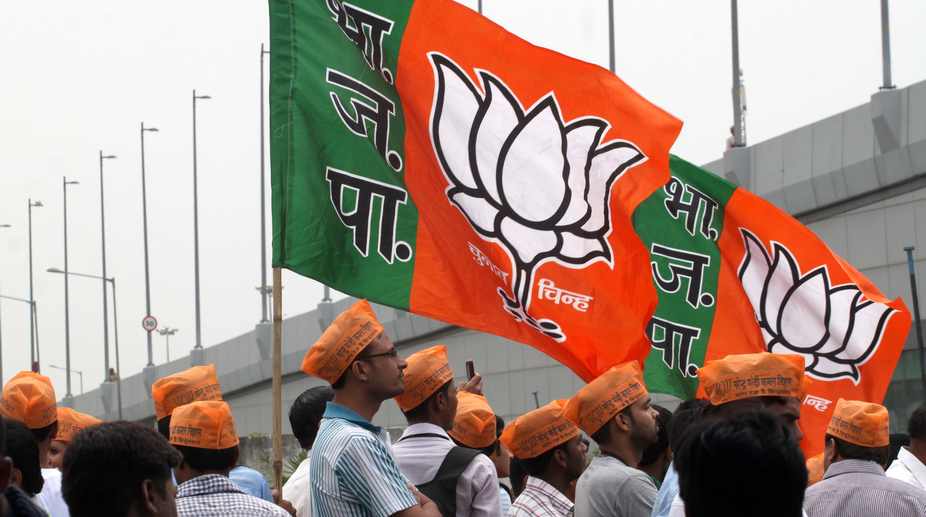From Ayodhya to Modi: BJP’s Dominance in Indian Politics
From Ayodhya to Modi: BJP’s Dominance in Indian Politics.

Image Source: thestatesman.com
From Ayodhya to Modi: BJP’s Dominance in Indian Politics.
The Ascent of BJP: Unveiling India’s Largest Political Force Through a Thousand Words
The Bharatiya Janata Party (BJP) has etched its name as India’s most prominent ruling party, a journey marked by strategic evolution, dynamic leadership, and pivotal shifts in the political paradigm. This narrative delves into the factors that propelled the BJP to its preeminent position in Indian politics, spanning a thousand words to capture the essence of its rise.
1. Origins and Formation: The BJP traces its roots to the Bharatiya Jana Sangh, founded in 1951 by Syama Prasad Mookerjee. Mergers and alliances in subsequent years led to the establishment of the BJP in 1980. The party embraced a fusion of cultural nationalism and Hindutva, aiming to articulate the interests of the Hindu majority.
2. Role in the Ayodhya Movement: The late 1980s witnessed the BJP gaining prominence through active involvement in the Ayodhya movement. The party lent robust support to the demand for constructing a Ram temple at the disputed site in Ayodhya, consolidating Hindu votes and mobilizing widespread support.
3. Electoral Strategies in the 1990s: The 1990s marked a pivotal turning point for the BJP. The party strategically positioned itself as a proponent of economic reforms and good governance. Led by Atal Bihari Vajpayee and Lal Krishna Advani, the BJP formed a coalition government in 1996, albeit briefly, and later in 1998.
4. Pokhran II and National Security Focus: The successful nuclear tests in 1998, known as Pokhran II, bolstered the BJP’s image as a party prioritizing national security. The assertive foreign policy and a resolute stance on defense matters resonated with a substantial section of the electorate.
5. Coalition Politics and NDA Government: The BJP’s adeptness in forging alliances and collaborating with regional parties played a crucial role in its electoral successes. The formation of the National Democratic Alliance (NDA) in 1998, with the BJP at its core, solidified the party’s position as a coalition leader.
6. Economic Reforms and ‘India Shining’: In the early 2000s, the BJP-led government under Prime Minister Atal Bihari Vajpayee implemented significant economic reforms, launching the ‘India Shining’ campaign to showcase the country’s progress. However, the 2004 elections witnessed a surprising defeat for the BJP.
7. Revival and Narendra Modi’s Leadership: The BJP underwent a resurgence under the leadership of Narendra Modi. As Chief Minister of Gujarat, Modi’s tenure was marked by remarkable economic development, and his image as a decisive leader catapulted him onto the national stage. The 2014 general elections saw the BJP securing a decisive victory, forming a majority government.
8. Groundbreaking 2019 Victory: In the 2019 elections, the BJP secured an even more resounding victory under Narendra Modi’s leadership. The party won an absolute majority on its own, reflecting the widespread acceptance of its policies and the appeal of Modi’s leadership.
9. Major Policy Initiatives: The BJP’s electoral successes have been closely tied to its policy initiatives. Schemes such as Swachh Bharat Abhiyan, Pradhan Mantri Jan Dhan Yojana, and the implementation of the Goods and Services Tax (GST) showcased the government’s commitment to development and social welfare.
10. Effective Communication and Social Media Presence: The BJP’s adept use of communication strategies, including a robust presence on social media platforms, played a crucial role in shaping public perception. The party leveraged technology to connect with voters and disseminate its policies and achievements.
11. Populist Measures and Welfare Programs: The BJP’s focus on populist measures, coupled with welfare programs like Ujjwala Yojana and Ayushman Bharat, endeared the party to various segments of the population. These initiatives aimed at addressing the needs of the common citizen, especially in rural areas.
12. Strategic Alliances and State-level Successes: The BJP’s success extends beyond national politics. Strategic alliances with regional parties and impressive performances in state elections, particularly in states like Uttar Pradesh, Karnataka, and Gujarat, have contributed to its dominance.
Conclusion: The BJP’s journey to becoming India’s largest ruling party is a tale of strategic adaptability, dynamic leadership, and a keen understanding of the pulse of the electorate. From its roots in cultural nationalism to embracing economic reforms and championing welfare programs, the party has evolved to address the diverse aspirations of the Indian populace. As it continues to navigate the complexities of governance, the BJP’s trajectory remains a dynamic and influential force in the ever-evolving landscape of Indian politics.
From Ayodhya to Modi: BJP’s Dominance in Indian Politics.
Author: Harendra Kukna

Leave a comment